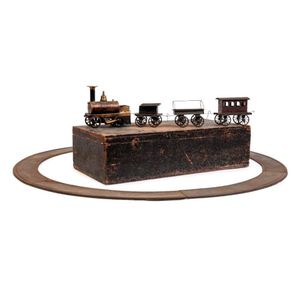Antique Ernst Plank Live Steam Passenger Set with Box
You must be a subscriber, and be logged in to view price and dealer details.
Subscribe Now to view actual auction price for this item
When you subscribe, you have the option of setting the currency in which to display prices to $Au, $US, $NZ or Stg.
- Live Steam - Live steam models are small, usually scale models of steam-powered vehicles or machinery that use real steam to power their movement. These models can be incredibly detailed and complex, often featuring working pistons, cylinders, and other steam-powered components.
Live steam models are typically made by hobbyists and enthusiasts, who enjoy building and operating these miniature steam-powered machines. They can be used to create working replicas of everything from steam locomotives and steamboats to steam engines and traction engines. - Diecast - The toy is made by by pouring molten metal into a closed metal die or mould. The first metal used was a lead alloy, but the finsihed product was very soft and broke easily, and was replaced with an alloy of zinc mixed with small amounts of aluminium and copper.
- Gauge - The first model railways had a track width of 48mm (1.89 inches) which was named 1 gauge. With smaller key-wind locomotives a narrower gauge was introduced, call 0 gauge, and then in the early 20th century "half 0" (or HO) gauge was introduced. In Britain and the Commonwealth countries this was called "00" gauge.
- Circa - A Latin term meaning 'about', often used in the antique trade to give an approximate date for the piece, usually considered to be five years on either side of the circa year. Thus, circa 1900 means the piece was made about 1900, probably between 1895 and 1905. The expression is sometimes abbreviated to c.1900.
This item has been included into following indexes:
- Plank, Ernst (Germany) - tinplate toys 4
-
toy and model trains and railways, manufacturers
- other makers 480
- steam powered 113
Visually similar items

A rare majolica glaze basket, attributed to Rupert Campbell, marked with initials R. J. C. and dated 1/12/11, 16 cm high

A pair of Chinese export paintings, circa 1854, Chinese school, Macau, each one in oil on canvas, 'Pira Grande from the South', 56 x 45 cm

Whitefriars mid 20th century Vase encased streaky purple & brown glass, 17 cm height

Early Aboriginal hardwood woomera with carved emu and kangaroo decoration
